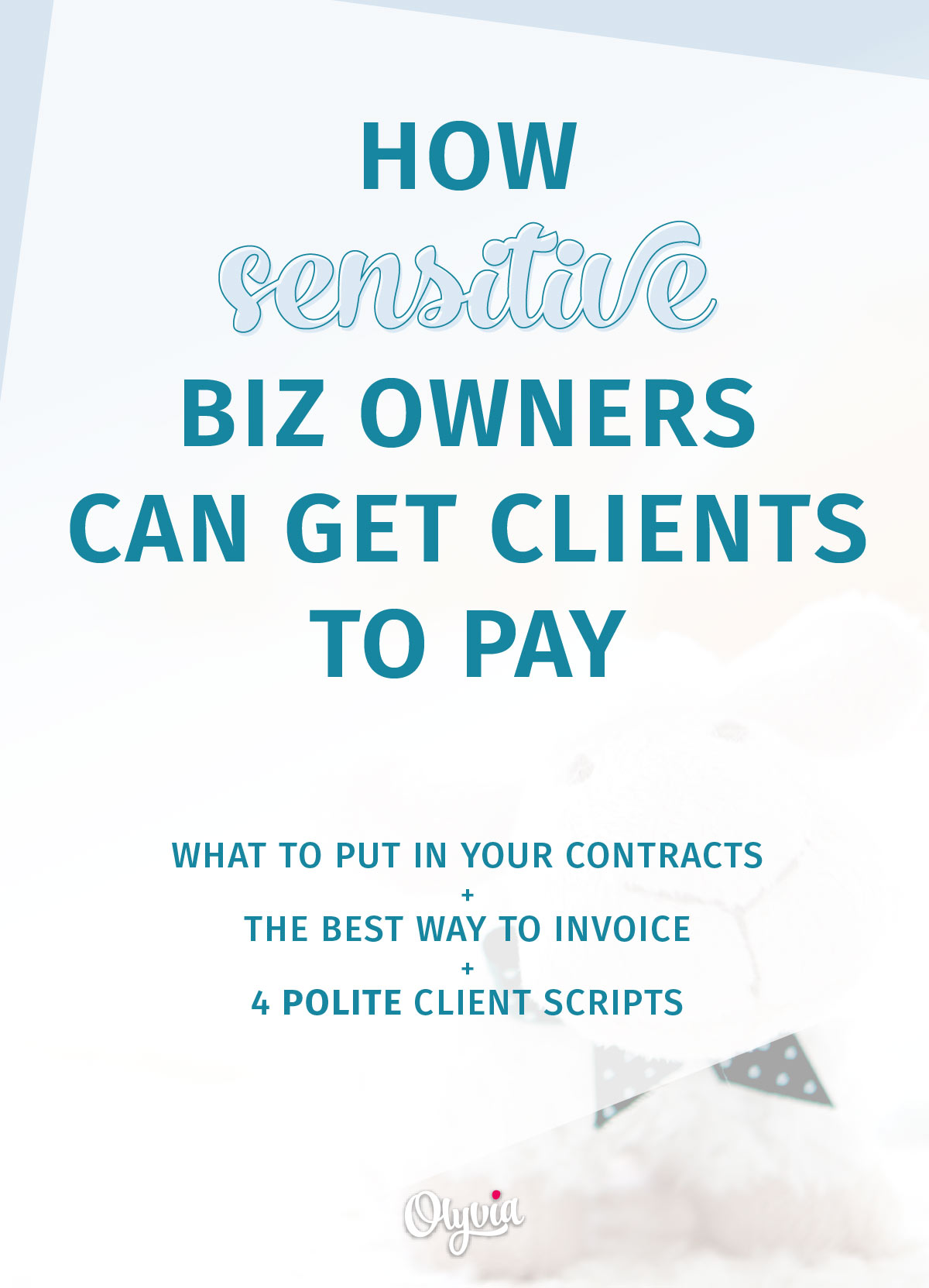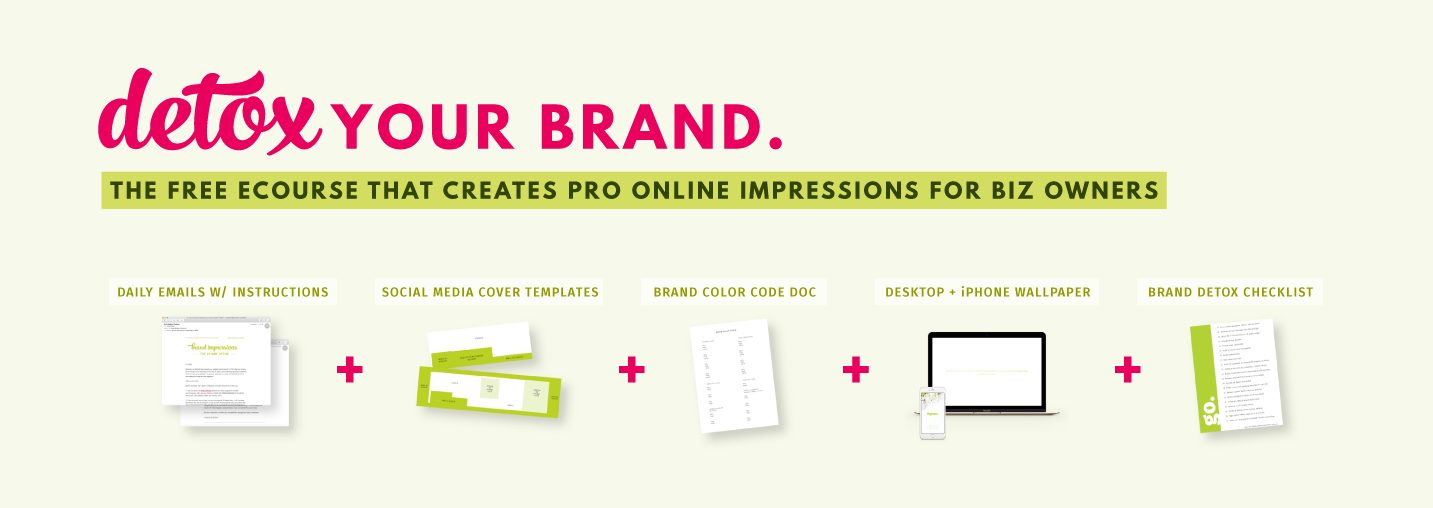How To Get Clients To Pay (For Sensitive Business Owners + Creatives)

Dear fabulous creativepreneur, freelancer, or service-based business owner,
Does the prospect of talking with a client about money give you sweaty palms?
Have you ever ended up losing money — or not getting paid at all — because you were too afraid to push for payment?
Does your reasoning for not pushing said payment sound anything like the phrases below?
“I don’t want to come off sounding demanding and harm my reputation.” // “I’m afraid I’ll look money-hungry.” // “Well she IS a friend of mine.” // “I really want to avoid starting a nasty fight.” // “Maybe the check is in the mail and I’ll get it next week.” // “I have no idea what to even say!”
If so, I love you + let me buy you a latte.
You’re not the only one, nor are you the “bad business owner” you fear that you are.
What you might be?
Shy.
Introverted.
Even “sensitive.” (And by the way? I’m claiming that word for all positive things, NOT the “ohhh you’re just too sensitive, get over it” remarks that not-nice non-sensitive people like to say.)
But lousy, incompetent, and all those other awful things?
No. Those words will not be uttered on my blog.
So let’s talk, generous woman. How do people like you and I get clients to pay up without coming off as greedy + cold?
I just happen to have a few tips (plus 4 fill-in-the-blank client scripts!) for you, as well as a fun service challenge I’ll tell you about at the bottom of this post:
HOW TO GET CLIENTS TO PAY: THE PAY-IN-ADVANCE METHOD
As #SensitiveEntrepreneurs, we are also people who tend to feel a heavy responsibility to go above and beyond to help others. (Am I right, or am I right?)
This is a beautiful quality — I’m convinced the world needs people like us, especially in business — but we must be wise to the fact that it’s also our biggest blind spot.
This blind spot can lead us to get SO caught up in our sense of duty in helping others achieve success or happiness that we do hours or weeks or even months of hard work…for free.
Of course, sometimes this does work for us. We eventually get paid in the end, the client is happy, and all is right with the world.
If we’re fortunate enough, we can operate in this blind spot for years and never realize it.
But, inevitably, the time comes when we muster the nerve to present an invoice and instead of getting paid, we’re met with something much different.
The two most common scenarios?
A) The client refuses to communicate, or
B) The client is insistent that they shouldn’t have to pay because of reasons X, Y, and $^%Q#*
Either one means a painful lesson for you — and your business.
(Oh, you were hoping to pay your bills this month with that project? Har har har!)
That’s why I’m a passionate advocate for “The Sensitive Business Owner’s Blind Spot Protection & Prevention Plan.”
Otherwise known as: payment in advance.
Now, I know. This is where some of you start to get nervous.
“How can I ask for money up front?! I adore my clients, I want them to be like family. (In fact, some of them ARE family!) It seems so evil and greedy and icky to get money before I’ve given them every last ounce of my energy + time first!”
Dear friend, to you I say this:
Your job as Business Owner is to help your client succeed, but it’s also your responsibility to ensure your business stays “in business.” (Click to tweet)
This is not a stone-hearted, may-everyone-perish-while-I-live-in-luxury philosophy.
This is, as our grandpappy’s used to say, “good ole’ common sense.”
It’s also the ONLY way you can keep on helping people.
(Because if you can’t make the money you need, when you need it, your business will not survive. #It’sAboutToGetReal)
So what I’m going to do is help you set up some clear standards for getting paid in a manner that’s both wise for you, and reasonable for your clients:
How To Set Up (An Effective) Payment Plan
1. Use a solid contract. (Because if it doesn’t happen in writing, it doesn’t happen.) You can use free templates around the web as a starting point — such as this one from the Freelancer’s Union — but this is an area where you will want to consider supplementing with an attorney. I promise you, money spent up front in prevention will save you 10x that in cure.
2. Write a clear statement indicating your deposit + incremental payment amounts, and when they’re due. In the services-based fields, deposits (or retainers) are the norm, so don’t be afraid of them. They’re your best tool in weeding out the tire-kickers from the serious clients who are willing to pay for the value you provide.
The ongoing payments help your client pay in more manageable amounts, while helping you achieve a more regular income + avoid working for free if a client stops paying.
And be smart with your due dates. If there are final projects to be delivered (a website, a video, a photo album), I advise my clients to always get the last payment in hand before anything is turned over. Once you lose that leverage, it’s much more difficult to work with a non-paying client.
A common payment breakdown many use for project-based services is this:
50% downpayment, 25% midway through (or at some distinguishable point in your work process), and 25% due before delivery.
That’s OK, but for the best protection, I’d recommend trying something more like: 50%, 35%, 15% OR 50%, 20%, 20%, 10%.
And if it’s month-to-month consulting or coaching you offer, you’ll want to collect payment on or before the 1st of the month for that month’s work.
Pssst. Oh, and something else: if you work on a waiting list basis, take at least 10% to secure a spot on your schedule! The last thing you want to do is reserve a 6 week spot for a potential client, only to have them later decide to scrap their plans…and leave you scrambling for business. A small deposit makes people get — and stay — serious.
3. Be specific about what happens if a payment is missed. It’s easier to say all work will cease in a contract and refer back to it than it is to try to explain it to a charismatic client who keeps “promising” they’ll get the payment “soon.” So use this opportunity to be as detailed as possible.
Will you stop the work entirely until payment is made? Will you stop work and issue a small fee (and for how much?) for resuming work? Will you have a time frame for resuming payment (ie: 3 weeks) that, if missed, allows you to back out of the project completely?
4. Repeat the terms to your new client (in an intro email or on a piece of paper in your ‘client welcome kit’). As much as we like to imagine our clients sitting down to study every last “wherefore” and “whereas” in our contracts, the fact is that it’s a legal document. People take one look at them and their brains literally shut down.
If you want to make for realsies sure there’s no possibility for miscommunication down the road, you’ll want to (nicely, of course) remind them — in non-legal language — of your payment terms as part of your other initial communications with them.
What This Plan Teaches Your (Potential) Clients
By taking this simple step, you’re doing a powerful thing. You’re teaching people how to treat you.

Having clear, professional payment terms helps people understand that you are a REAL business (because you’re operating like one). When we don’t do have those terms, we give the impression to people that we’re just “the girl who messes around with this stuff in her spare time, no big deal.”
This casualness on our part leads our clients to believe they can be casual, too. Right down to their pocketbooks.
The best way to get people to take your business seriously is for you to start TREATING it seriously. (Click to tweet)
Remember that.
HOW TO GET CLIENTS TO PAY: COLLECTING FINAL PAYMENTS
If you’re going to have trouble getting paid by a client, it’s nearly always going to happen at the end of your working relationship when you send out the final invoice.
But (good news!) there are a few strategic things you can do right off the bat to make problems less likely:
1. Invoice right away. Remember, you’re responsible for setting the tone of your business. Being slow to bill sends the message to your clients that they can be slow to pay. As soon as you’ve finalized a project, send out an invoice. (Programs like Freshbooks <- happy affiliate link! make it easy. Other options: Harvest, Wave, 17Hats.)
Also: even if you’ve only been corresponding with your client via email, it’s a good idea to consider sending it via two different avenues (email AND postal mail). Again, you want to give the impression you’re serious — and you don’t want to risk your bill getting lost in their Inbox or Spam folders.
2. Be polite / include a personal note. Bills are intimidating to people. Even if they’re small, they cause stress. (And if they’re big, watch out.) Putting a human touch on your bill is an effective strategy to let people know there’s a friendly face on the other end, and lessens the chance they’ll throw it in their “I can’t even stand looking at this for the next 6 months, it’s so scary” pile.
You’ll want to use words like, “Please send your payment by…” instead of the more sterile, “Remit payment…” And don’t forget to include a “thank you!” somewhere.
3. Have an online payment option. This is the 21st century, my lovelies. 🙂 Unless your work is only with the 50+ crowd, sending in paper checks is viewed an added inconvenience…and slows payment time. Instead, provide a direct Paypal link, Selz link, or other means that someone can pay you online with just one or two clicks. You’ll be surprised at how much this will benefit your business’ bottom line.
Most of the time these methods are going to get you paid, but now let’s look at what happens if you’re at the point where you’ve sent out an invoice and the client has gone Missing In Action.
When A Client Isn’t Paying (or Communicating)
Even as the sensitive, introverted business owners that we are, having a client drop off the face of the planet when it’s time to fork over the cash can be…well, #HonestyTime…rage-inducing.
(There, I said it. Who’s with me, here?!)
At this point it’s important (mainly for your sanity) to assume the best:
There could be unforeseen cash flow problems, they could be under personal stress, or it could be a simple matter of someone who means well…but never learned good money habits + organization.
Even so, you DO deserve to be paid.
(And I don’t want any of you getting so nervous + upset at this point that you just cut your losses and move on.)
But knowing how to approach a clammed-up client nicely — yet effectively — can be difficult. You don’t want to come across as threatening or guilt-tripping, but you don’t want to sound like a beggar or a weakling either.
Here are a few professional starter scripts from my own files that you can use and modify as necessary:
4 (Polite But Pushover-Free) Client Scripts To Get Your Money
→ When you’ve already handed over all of the client’s project (and have no leverage)…
“The Benefit of the Doubt” script
Hi Valerie,
How is (insert thoughtful + upbeat question here about their munchkin/significant other/work/vacation planning/the weather…)? I’m just dropping you a note to be make sure you received the invoice I sent you (via email/via postal mail) on (insert exact date here) for the (insert service you provided here). You’re one of my favorite clients, and since (I didn’t hear back from you/it’s uncharacteristic not to hear from you), I’ve been concerned. I’d love to confirm that you got it and discuss any questions you may have!
I hope all is well, Valerie. I look forward to talking with you soon.
Warmly,
You
P.S. In the event you didn’t receive the invoice, I’ve gone ahead and attached it to this email for you. 🙂
WHY IT WORKS: For those who have honestly lost track of their bill-paying responsibilities, this gently gets them back on track without making them feel like a villain. It also gives people a dignified way out if they haven’t been communicating out of guilt.
The “Fond Memories” script
Maria,
It was (an honor/a blast/so rewarding/a blessing) to (be your wedding planner/design your logo/craft your business plan/be your doula/photograph your new baby/coach you through your job transition/edit your e-book)! I loved how (insert a highlight of the project or the results it obtained: how they got rave reviews on their logo, how stress-free they were on the wedding day, how their baby made utterly adorable faces during the shoot…). I am so happy I could be a part of that with you.
On that note, I’m touching base with you because I was doing my monthly bookkeeping yesterday and noticed I don’t have record of a final payment on your account. I know things have been (crazy/exciting/busy/wild) for everyone, so I wanted to be sure to drop you a friendly personal reminder about the invoice I sent on (insert exact date and method of delivery). 🙂 If you could get that to me by (insert exact date), (I’d be appreciative/I’ll just go in and waive the standard late fee for you/we can get this project wrapped up)!
Thanks so much, Maria.
Warmly,
You
WHY IT WORKS: This script reinforces the value of what you provided to the client. Sometimes clients don’t feel an urgency to pay because they soon forget the value of what they received. Reminding them of your great (and hard) work, plus their satisfaction (even a difficult project has its highlights), can be just the motivation they need to click on your payment link and hit ‘Send.’
→ When you’re waiting on a final payment in order to deliver the goods…
The “Time is of the Essence” + “A Way Out” script
Mark,
This is a friendly note to remind you that I have your (website/menu design/audit/manuscript/photographs/etc) completed and ready to deliver. I know you have been eager to receive it so you can proceed with your (launch/rebrand/research/other important business matters/etc)!
As you know, I only need the final payment of $___ due via (check/this Paypal link/etc) and then I can get it quickly (uploaded to your webhost/to the printer/emailed over). I’m (entering into my busy season/moving on to a new client project/getting married/preparing to go on maternity leave), so now is an ideal time for me to get this to you without any delays.
If unforeseen financial (obligations/difficulties) have sprung up, please let me know; because (you’re one of my favorite clients/we’ve had an excellent working relationship thus far/you’re a family friend/I want to see your business succeed), I’m more than happy to put together a payment plan for you.
Warmly,
You
WHY IT WORKS: A combo of my two favorite scripts, this one packs a heavy punch. Not only does it remind the client that A) you have their much-desired final product, it tells them that B) you are so busy that to wait any longer may mean further delays later. Plus, it opens up dialogue about possible financial difficulties the client is facing and lets them know you’re willing to take small chunks of payment over not getting paid at all. For the right client, it’s powerful.
→ If you’ve sent one of the above scripts + several invoices, but still can’t get in touch with the client, it’s time for…
The “Nice Girls Gone Tough” script
Claire,
I genuinely regret needing to send this letter. Because I have not heard from you in response to my (letter(s)/email(s)) on (insert date(s) here) and invoices on (insert dates here), I am going to need to (shelve your project/bring in my attorney/hand your information over to my collection agency).
(If you haven’t delivered the final product yet, you can insert this script: I keep undelivered client (files/projects/etc) on hand for (one week/two weeks/other time frame here) after this notice, and then they are archived. The cost to procure your _______ after (insert exact date here) will be an additional $____ on top of the final bill (+ applicable late fees).)
I hate to end our working relationship on this note. It is my sincere hope we can resolve this before proceeding to more serious measures. Please (respond/call) by (insert exact date here). Thank you.
You
WHY IT WORKS: Without sacrificing civility, this script strikes serious fear into the heart of an unrepentant non-payer. Unfortunately, some people just won’t act until they feel the heat of impending fire + brimstone upon their neck. Don’t be afraid to use it if you have to.
(But remember: if you say you’re going to bring in an attorney or send them to collections, you actually need to do that. Your reputation as a professional relies on you being able to make sober statements of fact, not empty threats.)
Now please share: have you ever had to fight for a paycheck from a client? What advice do you have on how to get clients to pay? Even if you’re not a #SensitiveEntrepreneur and have a steel stomach when it comes to dealing with difficult clients, I know you have some great tips for us!

(Chief Olyvia)





